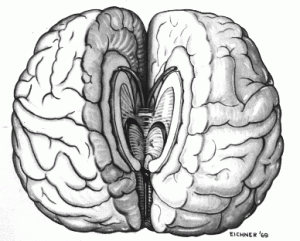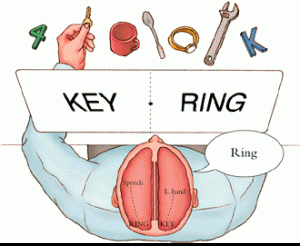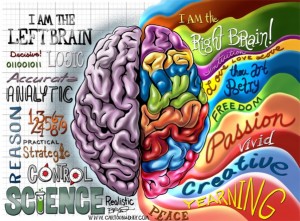In popular culture and media, the idea of hemispheric dominance has created a misunderstanding of brain function. One of the most popular misconceptions is the idea that hemispheric dominance is connected to personality type. This idea entirely oversimplifies the idea of the lateralization of brain function. In the widespread pop-culture version of hemispheric dominance, certain personality traits are assigned specifically to one side of the brain. Left-brained people are assumed to be logical, analytic, strategic, and practical. Right-brained people are understood to be passionate, creative, intuitive, and emotional. This idea is so infiltrated into popular belief that one search of “hemispheric dominance” yield pages and pages of results for left brain vs. right brain dominance tests. The amount of these tests indicate how many people are using these to evaluate their own way of thinking and behavior on a measure that has no scientific truth behind it. It is essential that people understand the neuroscience behind brain function in order to debunk the myth behind the lateralization of brain function.
 In order to analyze the concept of hemispheric dominance it is imperative to understand the history of split-brain experiments. In the early 1960’s Roger Sperry worked extensively with a severely epileptic patient that had his corpus collosum split. Sperry discovered that certain activities could only be accomplished when using one side of the brain, thus the concept of laterality. Laterality means the dominance of one side of the brain in controlling particular activities or functions.
In order to analyze the concept of hemispheric dominance it is imperative to understand the history of split-brain experiments. In the early 1960’s Roger Sperry worked extensively with a severely epileptic patient that had his corpus collosum split. Sperry discovered that certain activities could only be accomplished when using one side of the brain, thus the concept of laterality. Laterality means the dominance of one side of the brain in controlling particular activities or functions.
Sperry’s experiment led to a whole new branch of research aimed towards laterality and hemispheric dominance. Previous research has shown that language processing for 95% of people is mostly located in the left hemisphere in the form of Broca’s and Wernicke’s areas. The right hemisphere has proven to be responsible for spatial awareness along with memory, attention, and problem solving. Another intricacy involved with hemispheric dominance is contralateral control o f motor control, vision, and language.
f motor control, vision, and language.
Sperry’s research best describes contralateral cognitive processes. Images were flashed in front of subjects with severed corpus collosa. When an image was flashed in the subject’s right visual field (RVF) the image was being processed in the left hemisphere. Since language processes are generally based in the left hemisphere, the subject could verbally recall the object flashed in front of them. However, since motor control is usually based in the right hemisphere, the subject could not draw the object when prompted. When an image was flashed in front of the subject’s left visual field then the right hemisphere processed it. The contralateral processing resulted in an inability to verbally recall the object but the ability to draw the object remained in tact. Although there are well-documented instances of lateralization, there are also cognitive abilities that are ipsilateral. The most common example is olfactory processing.
Whilst it is true that each hemisphere of the brain has certain functional specializations, the substandard understanding of the existence of lateralization has lead pop psychological articles to depict the brain as being divided into two separate parts, almost independent of each other. This is a myth.
Pseudo-psychology often suggests that individuals are either ‘right-brained’ or ‘left-brained’ depending on their personality type, and often determine this from their jobs and personal life. For example, pop psychologists might be inclined to tell a musician that he is a ‘right brained’, whist telling a math teacher he is ‘left brained’. This is a massively over simplified understanding of how the two sides of the brain interact. For example linguistic functioning is associated with just the left side of the brain, but in reality the right side contributes a huge amount. Recent studies have indicated that individuals with damage to their right hemisphere often have trouble with semantics, and a reduced ability for metaphor appreciation, both vital aspects of language comprehension.
 In reality it appears that most basic cognitive processes utilize both sides of the brain, and the idea that an individual can being either left or right sided, is a huge exaggeration. The two hemispheres are massively interconnected by the corpus callosum as well as other bands of nerve fibers, which connect both sides of the brain. These allow many of the brain processes to span across both sides, and create a more holistic idea of consciousness.
In reality it appears that most basic cognitive processes utilize both sides of the brain, and the idea that an individual can being either left or right sided, is a huge exaggeration. The two hemispheres are massively interconnected by the corpus callosum as well as other bands of nerve fibers, which connect both sides of the brain. These allow many of the brain processes to span across both sides, and create a more holistic idea of consciousness.

